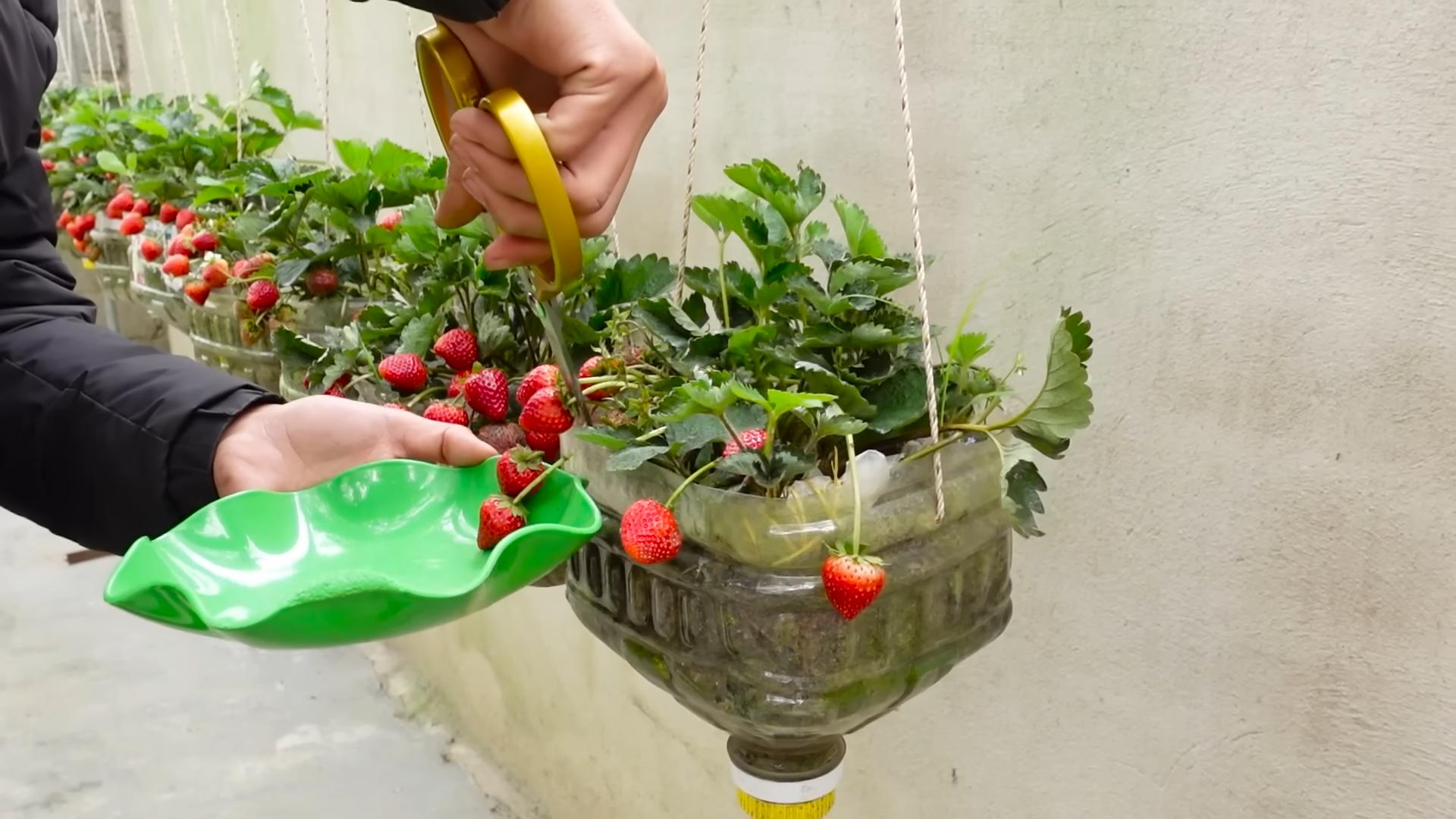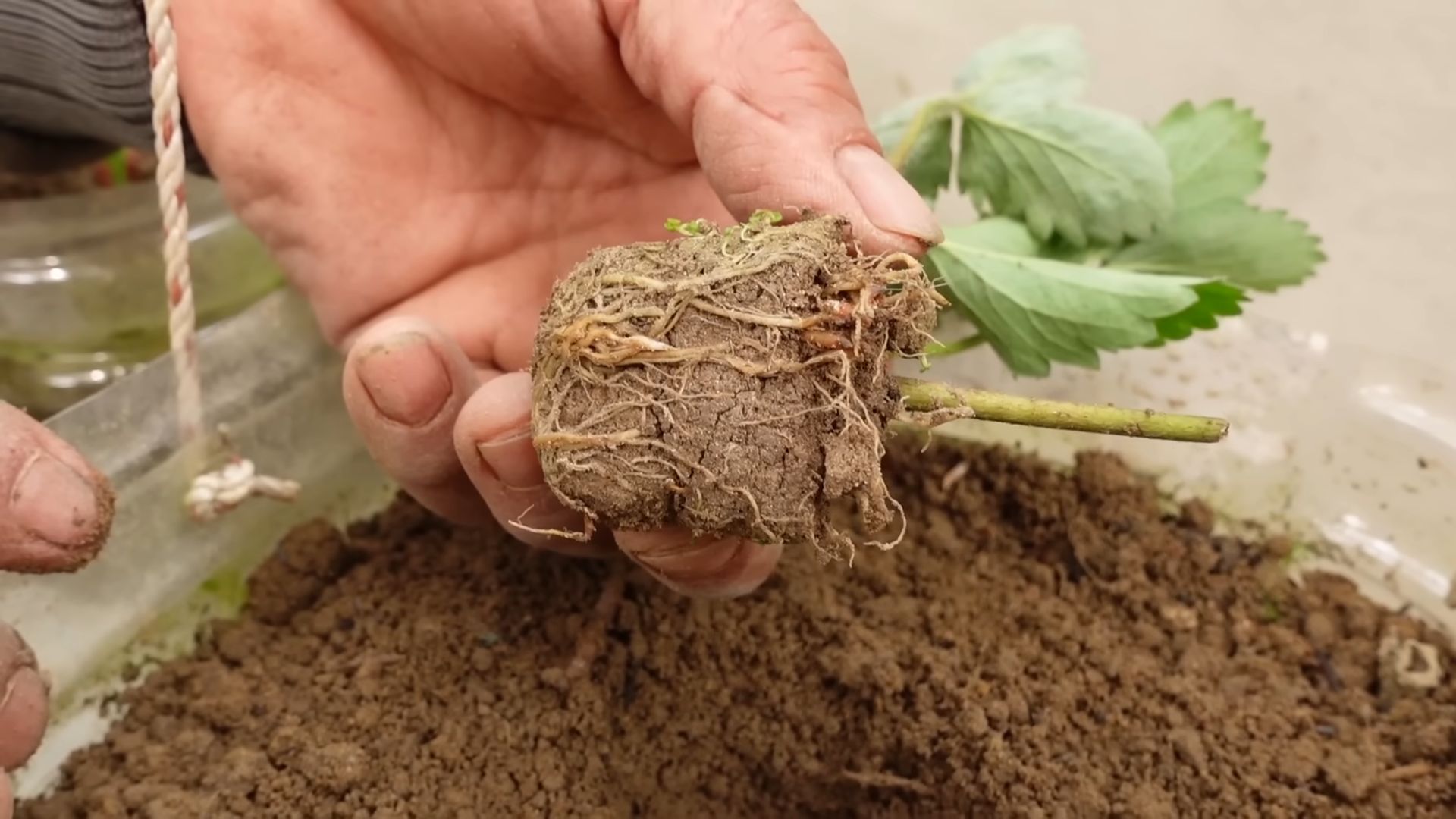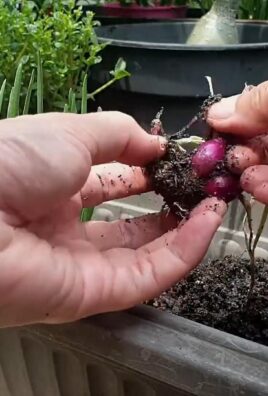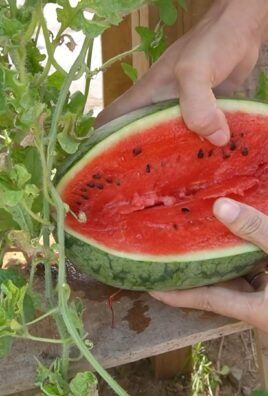Grow Strawberries at Home, and unlock a world of sweet, juicy goodness right in your backyard! Imagine plucking sun-ripened strawberries, bursting with flavor, just moments before you enjoy them. Forget those bland, store-bought berries – with a few simple tricks and a little DIY magic, you can cultivate your own thriving strawberry patch, no matter how small your space.
Strawberries have a rich history, dating back to ancient Rome, where they were prized for their medicinal properties. Over centuries, they’ve evolved from wild woodland berries to the cultivated delights we know and love today. For generations, families have cherished the tradition of growing their own strawberries, passing down secrets for bumper crops and the sweetest flavors.
Why should you embark on this delicious DIY adventure? Well, besides the obvious benefit of having fresh, organic strawberries at your fingertips, growing your own is incredibly rewarding. It’s a fantastic way to connect with nature, reduce your carbon footprint, and save money on groceries. Plus, let’s be honest, there’s nothing quite like the satisfaction of nurturing a plant from tiny seedling to fruit-bearing beauty. This article will guide you through easy-to-follow steps and clever hacks to grow strawberries at home successfully, even if you’re a complete beginner. I’m excited to share my favorite tips and tricks to help you create your own strawberry paradise!

Grow Delicious Strawberries at Home: A DIY Guide
Hey there, fellow gardening enthusiasts! I’m so excited to share my tried-and-true method for growing juicy, delicious strawberries right in your own backyard (or even on your balcony!). Forget those bland, store-bought berries – with a little effort, you can enjoy the sweet taste of homegrown strawberries all season long. This guide will walk you through everything you need to know, from choosing the right variety to harvesting your bounty. Let’s get started!
Choosing Your Strawberry Variety
Before you even think about planting, you need to decide which type of strawberry is right for you. There are three main types:
* June-Bearing: These strawberries produce one large crop, usually in late spring or early summer (hence the name!). They’re great if you want a big batch for jam-making or freezing.
* Everbearing: Don’t let the name fool you – everbearing strawberries don’t produce fruit continuously. Instead, they typically have two or three harvests: one in spring, one in late summer, and sometimes a smaller one in fall.
* Day-Neutral: These are the most consistent producers, fruiting throughout the growing season as long as the temperature is between 35°F and 85°F. They’re perfect for a steady supply of fresh berries.
Consider your climate and how much time you want to dedicate to harvesting when making your choice. I personally love day-neutral varieties because I enjoy having fresh strawberries available for a longer period.
Preparing Your Planting Area
Strawberries thrive in well-drained soil that’s rich in organic matter. Here’s how to get your planting area ready:
* Sunlight: Strawberries need at least 6-8 hours of sunlight per day. Choose a spot in your garden that gets plenty of sunshine.
* Soil Testing: It’s a good idea to test your soil’s pH. Strawberries prefer a slightly acidic soil with a pH between 5.5 and 6.5. You can buy a soil testing kit at most garden centers.
* Soil Amendment: Amend your soil with compost, aged manure, or other organic matter to improve drainage and fertility. Work the amendments into the soil to a depth of at least 12 inches.
* Weed Removal: Remove all weeds from the planting area. Weeds compete with strawberries for nutrients and water.
* Raised Beds (Optional): Consider planting your strawberries in raised beds. Raised beds improve drainage and make it easier to control weeds.
Planting Your Strawberries
Now for the fun part – planting!
1. Timing: The best time to plant strawberries is in early spring or late fall. This gives the plants time to establish themselves before the heat of summer or the cold of winter.
2. Spacing: Space your strawberry plants about 12-18 inches apart in rows that are 3-4 feet apart. This allows for good air circulation and prevents overcrowding.
3. Planting Depth: Dig a hole that’s large enough to accommodate the root ball of the strawberry plant. Make sure the crown of the plant (the point where the roots meet the stem) is level with the soil surface. Planting too deep can cause the crown to rot.
4. Watering: Water the newly planted strawberries thoroughly. This helps to settle the soil around the roots and encourages growth.
5. Mulching: Apply a layer of mulch around the strawberry plants. Mulch helps to retain moisture, suppress weeds, and keep the berries clean. Straw, pine needles, or wood chips are all good choices for mulch.
Caring for Your Strawberry Plants
Once your strawberries are planted, it’s important to provide them with the care they need to thrive.
* Watering: Water your strawberry plants regularly, especially during dry periods. Aim to keep the soil consistently moist but not waterlogged. Drip irrigation is a great way to water strawberries because it delivers water directly to the roots and minimizes leaf wetness, which can help prevent fungal diseases.
* Fertilizing: Fertilize your strawberry plants every 4-6 weeks with a balanced fertilizer. Follow the instructions on the fertilizer package. Avoid over-fertilizing, as this can lead to excessive foliage growth and reduced fruit production.
* Weed Control: Keep your strawberry patch free of weeds. Hand-pull weeds regularly or use a hoe to cultivate the soil around the plants. Be careful not to damage the strawberry plants’ roots when weeding.
* Pest and Disease Control: Monitor your strawberry plants for pests and diseases. Common strawberry pests include aphids, spider mites, and slugs. Common strawberry diseases include gray mold, leaf spot, and powdery mildew. Treat any problems promptly with appropriate insecticides or fungicides. Organic options are available and often preferred.
* Runner Management: Strawberry plants produce runners, which are long stems that grow horizontally and develop new plantlets at their tips. If you want to maximize fruit production, remove the runners as they appear. This will encourage the plants to put their energy into producing berries instead of new plants. However, if you want to propagate new strawberry plants, you can allow the runners to root in the soil.
* Protecting from Birds: Birds love strawberries just as much as we do! To protect your berries from birds, you can cover your strawberry patch with netting.
Harvesting Your Strawberries
The moment you’ve been waiting for! Harvesting your strawberries is the most rewarding part of the process.
1. Ripeness: Strawberries are ready to harvest when they are fully red and slightly soft to the touch.
2. Harvesting Technique: Gently twist or cut the strawberry from the plant, leaving a small piece of the stem attached.
3. Timing: Harvest your strawberries in the morning, after the dew has dried. This is when the berries are at their peak flavor.
4. Storage: Store your freshly harvested strawberries in the refrigerator. They will keep for several days.
Extending Your Strawberry Season
Want to enjoy strawberries for even longer? Here are a few tips:
* Succession Planting: Plant different varieties of strawberries that ripen at different times. This will extend your harvest season.
* Row Covers: Use row covers to protect your strawberry plants from frost in the spring and fall. This can help you get an earlier start to the season and extend it later into the fall.
* Cold Frames: Grow your strawberries in a cold frame to protect them from the elements and extend the growing season.
Growing Strawberries in Containers
Don’t have a garden? No problem! You can grow strawberries in containers.
* Container Selection: Choose a container that is at least 12 inches deep and wide. Make sure the container has drainage holes.
* Potting Mix: Use a high-quality potting mix that is well-draining.
* Planting: Plant your strawberry plants in the container, following the same spacing guidelines as for planting in the ground.
* Care: Water and fertilize your container-grown strawberries regularly. Place the container in a sunny location.
* Overwintering: In cold climates, you will need to protect your container-grown strawberries from freezing temperatures. You can move the container to a sheltered location, such as a garage or shed, or you can wrap the container in burlap or bubble wrap.
Troubleshooting Common Strawberry Problems
Even with the best care, you may encounter some problems when growing strawberries. Here are some common issues and how to address them:
* Small Berries: Small berries can be caused by a variety of factors, including insufficient sunlight, poor soil, and overcrowding. Make sure your strawberry plants are getting enough sunlight, amend the soil with compost, and thin out the plants if they are overcrowded.
* Rotting Berries: Rotting berries can be caused by fungal diseases, such as gray mold. To prevent rotting berries, provide good air circulation around the plants, avoid overhead watering, and remove any infected berries promptly.
* Pest Infestations: Monitor your strawberry plants for pests and treat any infestations promptly with appropriate insecticides.
* Lack of Fruit: A lack of fruit can be caused by a variety of factors, including insufficient sunlight, poor pollination, and nutrient deficiencies. Make sure your strawberry plants are getting enough sunlight, provide good pollination by attracting bees to your garden, and fertilize the plants regularly.
Propagating New Strawberry Plants
If you want to expand your strawberry patch, you can propagate new plants from runners.
1. Allow Runners to Root: Allow the runners to root in the soil. You can help them root by placing a small rock or brick on top of the runner where it touches the soil.
2. Separate the Plantlet: Once the plantlet has developed roots, you can separate it from the mother plant by cutting the runner.
3. Transplant the Plantlet: Transplant the plantlet to a new location in your garden or to a container.
Enjoying Your Homegrown Strawberries
Congratulations! You’ve successfully

Conclusion
So, there you have it! Growing strawberries at home isn’t just a whimsical dream; it’s an achievable reality, even without a sprawling garden. This DIY trick, focusing on vertical planters or container gardening, opens up a world of fresh, juicy, and intensely flavorful strawberries right at your fingertips. Forget the bland, often disappointing berries from the supermarket; imagine plucking sun-ripened sweetness straight from your own homegrown patch.
Why is this a must-try? Because it’s more than just a recipe for growing fruit; it’s a recipe for creating a sustainable, rewarding, and delicious experience. It’s about connecting with nature, even in the smallest of spaces. It’s about knowing exactly where your food comes from and enjoying the unparalleled taste of freshly harvested produce. And let’s be honest, there’s a certain satisfaction that comes from nurturing something from a tiny seedling to a bountiful harvest.
But the beauty of this DIY approach lies in its adaptability. Feel free to experiment with different varieties of strawberries. Everbearing varieties will provide fruit throughout the growing season, while June-bearing varieties offer a concentrated harvest. Consider adding companion plants like basil or marigolds to deter pests naturally. You can also explore different container materials – terracotta pots, recycled buckets, or even repurposed pallets can all be transformed into charming strawberry homes. For those with limited sunlight, consider investing in a grow light to ensure your plants receive the necessary energy.
Don’t be afraid to get creative with your setup! A tiered vertical planter can add a touch of elegance to your balcony, while a hanging basket overflowing with strawberries creates a whimsical focal point. The possibilities are endless, and the only limit is your imagination.
This DIY strawberry growing method is a game-changer for anyone who loves fresh fruit and enjoys a little hands-on gardening. It’s a simple, cost-effective, and incredibly rewarding way to bring the taste of summer to your home, no matter how small your space may be.
We wholeheartedly encourage you to give this DIY trick a try. Start small, learn as you go, and don’t be discouraged by initial setbacks. Gardening is a journey, and every mistake is a learning opportunity.
And most importantly, we want to hear about your experience! Share your photos, tips, and triumphs in the comments below. Let’s create a community of home strawberry growers, sharing our knowledge and inspiring each other to cultivate the sweetest, most delicious berries imaginable. What variety did you choose? What challenges did you face, and how did you overcome them? Your insights could be invaluable to other aspiring strawberry farmers. So, grab your gardening gloves, gather your supplies, and get ready to embark on a delicious adventure! Happy growing!
Frequently Asked Questions (FAQ)
What kind of soil is best for growing strawberries in containers?
Strawberries thrive in well-draining, slightly acidic soil. A good mix consists of equal parts potting soil, compost, and peat moss (or coconut coir as a sustainable alternative). Avoid using garden soil, as it can become compacted in containers and hinder drainage. The ideal pH range is between 5.5 and 6.5. You can test your soil’s pH using a simple soil testing kit available at most garden centers. Amending the soil with sulfur can help lower the pH if it’s too alkaline.
How often should I water my strawberry plants?
Watering frequency depends on several factors, including the weather, the type of container, and the stage of growth. Generally, strawberries need consistent moisture, especially during flowering and fruiting. Check the soil moisture regularly by sticking your finger about an inch into the soil. If it feels dry, it’s time to water. Water deeply until you see water draining from the bottom of the container. Avoid overwatering, as this can lead to root rot. During hot, dry weather, you may need to water daily. In cooler, wetter conditions, you can reduce the frequency. Using a self-watering container or adding mulch to the surface of the soil can help retain moisture.
How much sunlight do strawberries need?
Strawberries need at least 6-8 hours of direct sunlight per day to produce a good crop of fruit. If you don’t have a sunny spot, consider using a grow light. Place your strawberry plants in the sunniest location you have available. If you live in a particularly hot climate, some afternoon shade can be beneficial to prevent the plants from overheating. Rotate your containers regularly to ensure that all sides of the plants receive adequate sunlight.
What kind of fertilizer should I use for strawberries?
Strawberries benefit from regular fertilization, especially during the growing season. Use a balanced fertilizer with an NPK ratio of 10-10-10 or 12-12-12. You can also use a fertilizer specifically formulated for berries. Apply the fertilizer according to the package directions, usually every 2-4 weeks. Avoid over-fertilizing, as this can burn the roots. Organic options like compost tea or fish emulsion are also excellent choices. During the dormant season (winter), reduce or eliminate fertilization.
How do I protect my strawberries from pests and diseases?
Several pests and diseases can affect strawberry plants. Common pests include aphids, spider mites, and slugs. Diseases include gray mold, leaf spot, and root rot. Regularly inspect your plants for signs of pests or diseases. Remove any affected leaves or fruit immediately. Use organic pest control methods like insecticidal soap or neem oil to control pests. Ensure good air circulation around your plants to prevent fungal diseases. Avoid overhead watering, as this can create a humid environment that encourages disease. Consider using netting to protect your berries from birds.
Can I grow strawberries indoors?
Yes, you can grow strawberries indoors, but it requires providing them with the right conditions. You’ll need a sunny window or a grow light to provide adequate light. Choose a self-pollinating variety of strawberry. Hand-pollinate the flowers using a small brush to ensure fruit production. Maintain a consistent temperature and humidity level. Water regularly and fertilize as needed.
How do I overwinter my strawberry plants?
In colder climates, strawberry plants need protection during the winter. After the first frost, cut back the foliage to about 2 inches above the crown. Mulch heavily with straw or leaves to insulate the roots. If you’re growing strawberries in containers, you can move them to a sheltered location like a garage or shed. Water sparingly during the winter to prevent the soil from drying out completely. In the spring, remove the mulch gradually as the weather warms up.
What are the best varieties of strawberries to grow in containers?
Several strawberry varieties are well-suited for container gardening. Everbearing varieties like ‘Seascape,’ ‘Albion,’ and ‘Ozark Beauty’ produce fruit throughout the growing season. June-bearing varieties like ‘Honeoye’ and ‘Earliglow’ offer a concentrated harvest in the spring. Day-neutral varieties like ‘Tristar’ and ‘Tribute’ produce fruit continuously as long as the temperature is between 35-85 degrees F. Consider your climate and personal preferences when choosing a variety.
How long does it take for strawberries to produce fruit?
The time it takes for strawberries to produce fruit depends on the variety and growing conditions. June-bearing varieties typically produce fruit in the spring of the year following planting. Everbearing and day-neutral varieties may produce some fruit in the first year, but the main harvest will be in the second year. Be patient and provide your plants with the care they need, and you’ll be rewarded with a bountiful harvest.
How do I know when my strawberries are ripe?
Strawberries are ripe when they are fully red and slightly soft to the touch. The berries should detach easily from the plant. Taste a berry to ensure it’s sweet and flavorful. Pick the berries in the morning when they are cool and dry. Store them in the refrigerator for up to a week. Enjoy your homegrown strawberries fresh, in jams, or in your favorite desserts!





Leave a Comment